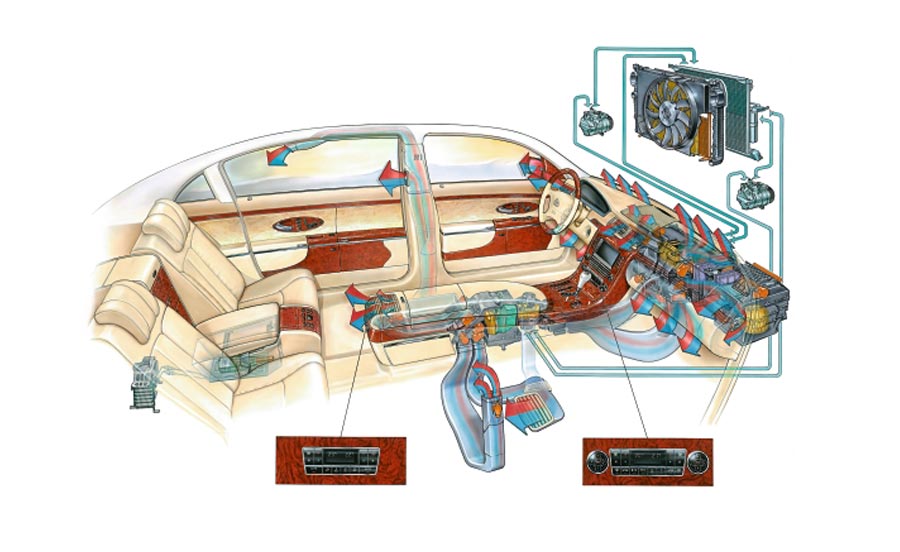Thermal management
As we all know, engine compartments have got much smaller, resulting in an enormous build-up of heat that must be dissipated. Much is being asked of modern cooling systems where cooling down...
Function
Thermal management: The engine cooling system
As we all know, engine compartments have got much smaller, resulting in an enormous build-up of heat that must be dissipated. Much is being asked of modern cooling systems where cooling down the engine compartment is concerned. In response, significant progress has been made recently in the field of cooling.

A cooling system must meet the following requirements:
- Shorter warm-up phase
- Faster passenger compartment heating
- Low fuel consumption
- Longer service life of components
Components of engine cooling systems
The following components provide the basis for all engine cooling systems:
- Radiator
- Thermostat
- Coolant pump (mechanical or electric)
- Expansion tank
- Lines
- Engine fan (driven by a V-belt or Visco®)
- Temperature sensor (engine control/display)
Radiator
Radiators are installed in the air flow at the vehicle's front end. It is their job to release the heat generated as a result of combustion in the engine and absorbed by the coolant to the outside air.
Coolant pump
The coolant pump has a mechanical or electric drive; it conveys the coolant through the coolant circuit.
Radiator fan
One or more radiator fans driven mechanically or electrically support the coolant cooling process. The fans are located upstream or downstream of the radiator and can be electronically regulated.
Thermostat
The coolant thermostat, which is mechanically or electronically regulated, is located in the refrigerant circuit. It regulates the temperature of the coolant.
Heat exchanger
The heating valve, which is controlled mechanically, pneumatically or electrically, opens and closes the cooling circuit to the heat exchanger. Heat exchanger valve (optional) The air drawn from the passenger compartment fan is routed through the heat exchanger, being heated during this process.
Function:
Air-cooled or water-cooled after coolers must cool down the air compressed by the turbocharger in order to improve the efficiency of the engine. After coolers must be replaced following a mechanical fault affecting the turbocharger.
Components of vehicle climate control
Compressor
The compressor is driven by the vehicle engine via a V-belt. It compresses the gaseous refrigerant drawn in before forwarding it to the capacitor.
Capacitor
The capacitor is located upstream of the radiator. It cools the refrigerant coming from the compressor so that it leaves the capacitor as a liquid.
Filter dryer
The filter dryer removes impurities and moisture from the liquid refrigerant. It also acts as a refrigerant store. Inside the housing there is a granulate filter pad which can only absorb a certain amount of moisture.
Expansion valve
The expansion valve is the point separating the high pressure and low pressure areas. It regulates the flow of refrigerant depending on temperature, by injecting more or less liquid refrigerant into the evaporator. At the same time it passes the gas refrigerant from the evaporator on to the compressor
Safety
Thermal management safeguards the safe function of the engine regardless of operating conditions and weather conditions. Breakdowns due to the engine overheating and expensive repairs are thus avoided. The air conditioning also makes an important contribution to increasing safety and improving ride comfort. As drivers are subject to less physical stress and strain, they are better able to concentrate and respond. This helps to avoid accidents.
Depreciation
To ensure that thermal management functions reliably through the service life of the vehicle, compliance with the maintenance intervals prescribed by the vehicle manufacturer is mandatory. The cooling system is inspected as part of service and maintenance work. Specialists in garages test the antifreeze content of the coolant and check all system components for leaks and damage.
The vehicle's climate control equipment should also be checked by a garage at regular intervals. Hoses and seals age and dry out, coming loose and leaking as a result. This causes the refrigerant to evaporate and impairs cooling performance. The situation can be rectified by having the air conditioning checked and if necessary topped up with refrigerant. It is also advisable to have an AC service carried out every two years. An AC service includes for example replacing the refrigerant, checking for leaks and replacing the dryer if necessary.
Environmental protection
For minimum emissions, the engine must reach its operating temperature very quickly and maintain this temperature for the entire duration of operation. Thermal management makes a significant contribution here to creating the ideal conditions for efficient combustion with low levels of harmful substances.









